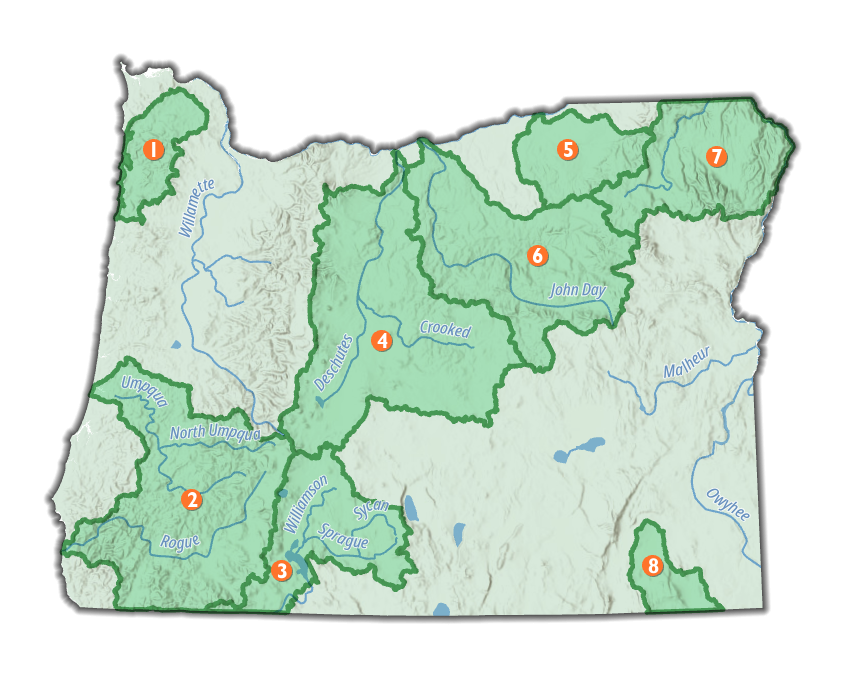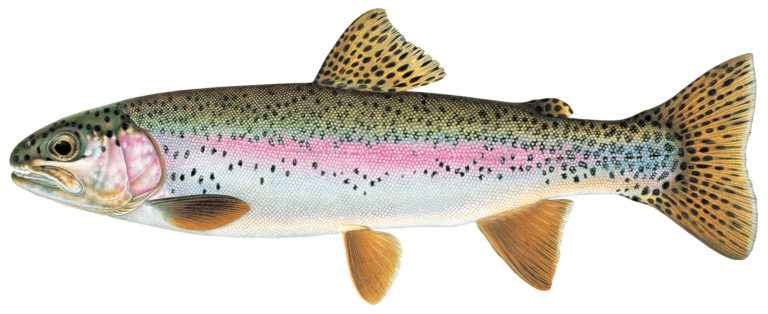Oregon

Overview
From the tributaries of the lower Snake and Columbia rivers to the closed Southeast basins, from the Upper Klamath to the steep coastal watersheds, Oregon’s rivers and streams are remarkable in their diversity. These watersheds span thick forests and high desert ecosystems, and they support keystone populations of native salmon, steelhead, Pacific lamprey, and resident trout. These species and the unique watersheds they call home are fundamental to Oregon’s cultural heritage and ecosystems. Across the state, TU is partnering with diverse communities of stakeholders and decision-makers to protect, restore, and build resiliency for these coldwater ecosystems and the native fish and communities that depend upon them.
Threats & Opportunities
Oregon’s salmon and trout need open migration corridors to spawning and rearing habitat, consistent sources of cold, clean water, fishery, and hatchery management focused on rebuilding populations and diversity, and an intact, complex, high-functioning habitat that supports all salmonid life stages. The growing impacts of climate change only add urgency to protect, reconnect, and restore these coldwater ecosystems.
How We Work
Reconnection
Reconnecting fish migration corridors is critical work in Oregon, encompassing both large mainstem dams and smaller structures on tributary streams. TU spent decades supporting the work to remove four dams on the Klamath and is working to breach four dams on the lower Snake while assuring that communities remain economically strong. On the rivers of Oregon’s North Coast, the Salmon SuperHwy is a model of collaboration between stakeholders working together to reconnect key tributary and estuary habitat for fish while building durable road infrastructure to protect people. Elsewhere in Oregon, we are reconnecting key tributaries in the Upper Klamath Basin and in the Southeast Closed Basin. TU’s advocacy efforts have led state agencies to expand requirements for and increase standards for fish passage across all state projects and waters.
Restoration
Across Oregon, we are leading projects to restore spawning and rearing habitat and rebuild ecological watershed function. This involves combinations of high- and low-tech work and seeks to reconnect floodplains and side channels, restore logjams and habitat complexity, and revegetate riparian habitat with native plants. In the Upper Klamath Basin, we are restoring habitat for bull trout and redband trout while preparing for the return of salmon, steelhead, and lamprey. In Northeast Oregon, we are at work in the Umatilla, John Day, Imnaha, and Grande Ronde watersheds to improve habitat for anadromous and resident fish.
Instream Flows
Across Oregon, we are ensuring dependable supplies of cold, clean water for fish and communities. Working with local municipalities, agencies, farmers and ranchers, and public and private landowners, we devise practical solutions to recharging groundwater with restoration projects, purchasing and leasing water for in-stream flows, and upgrading irrigation and water use efficiency. In the Deschutes, staff and volunteers are working together to improve water quality in the river’s mainstem and on the Crooked River.
Scientific Research
We look to the best available science to guide advocacy on fishery management, ensuring that we are focused on high-impact, efficient restoration projects and building resilience in the face of climate change. In the Upper Klamath Basin, we are partnering with agencies, academics, and tribes to release and track Chinook salmon smolts, important work that will guide restoration work as the dams come down and anadromous fish regain access to habitat after nearly a century. In the Klamath and elsewhere, we contribute to monitoring water quality, temperature, and fish populations to help understand the health of Oregon rivers and prioritize restoration. In the Umpqua watershed, we are pioneering the use of sonar as a fish-counting tool.
Advocacy
TU’s advocacy in state agency and legislative policy-making is built on a commitment to building forward-looking, durable solutions for watershed ecosystems and communities. Our work and good-faith collaboration have been key to fish passage, habitat protections, and forest health regulations that affect Priority Waters across the state. In every Priority Water, we push tirelessly for conservation-minded fishery and hatchery regulation guided by the best available science.
How You Can Help
Learn more about how we’re building pathways for salmon from the ocean to their home waters.
TAKE ACTIONStay informed about what we’re doing and how you can help in Oregon and across the Pacific Coast.
Learn more about how you can help us recover Oregon’s wild steelhead.
LEARN MORESupport the last best chance to recover Pacific salmon in the Snake River.
TAKE ACTIONOregon Conservation Team

Chrysten Rivard
Oregon State Director
chrysten.rivard@tu.org
Oregon State Director
chrysten.rivard@tu.org
Priority Waters

-
North Coast
The Salmon SuperHwy, a collaboration among Trout Unlimited, state and federal agencies, county government, and the agricultural community, is reconnecting 95 percent of historic fish habitat and building durable road infrastructure by replacing culverts and other fish migration barriers across six river basins draining into the Tillamook and Nestucca Bays. Beyond reconnecting key headwater spawning and rearing habitat, the Salmon SuperHwy is retrofitting tide gates and improving operations to expand and restore access to estuary habitat and restoring side channel and floodplain habitat. These watersheds are strongholds for Chinook, chum, and coho salmon, steelhead, and anadromous and resident cutthroat trout.
-
Southwest
To protect and rebuild the wild salmon and steelhead populations of the Rogue and Umpqua watersheds, TU is working alongside diverse regional stakeholders to advocate for conservation-minded fishery management, improved monitoring, and hatchery practices guided by the best available science. TU staff work to ensure adequate instream flows and protect coldwater refugia, and work with water users to improve water quality throughout the two basins. We work closely with regional partners to advocate for improved forestry practices, expanded Wild and Scenic protections on the Rogue, and the designation of Steamboat Creek as an Outstanding Resource Water of Oregon.
-
Upper Klamath
Amid the largest dam removal in history, TU is working to prepare the Upper Klamath Basin for the return of salmon, steelhead, and lamprey. Building on years of habitat restoration and instream flow protections benefitting native Bull Trout, Redband Trout, and endemic suckers (C’wamm and Koptu in the Klamath language). We have partnered with state and federal agencies, regional tribes, private landowners, and other conservation partners to prioritize and implement key restoration, monitoring and fish passage projects with the highest impact for rebuilding anadromous and endemic fish populations.
-
Deschutes
A large tributary of the mid-Columbia Basin, the Deschutes supports immensely popular steelhead and redband trout fisheries. The river basin was severed 60 years ago by the Pelton-Round Butte hydroelectric project. TU staff and volunteers are working to balance water quality protections with salmon, steelhead, and resident trout protections and reintroduction efforts. Together we’re working with local stakeholders and state and federal agencies to restore habitat in key tributaries, improve water quality on the Crooked River and Lower Deschutes, improve monitoring and municipal and irrigation water use efficiency, and restore fish passage to cold, clean upstream headwaters habitat.
-
Umatilla
The Umatilla Watershed is an important tributary to the mid-Columbia Basin, supporting key populations of spring and fall Chinook, coho salmon, summer steelhead, and resident fish. We are partnering with regional tribes, state and federal agencies, other conservation organizations, and the agricultural community of the basin to improve and extend streamflow duration on key tributaries, improve water use efficiency and sharing, and improve fishery management. We’re also leading restoration projects to reconnect floodplains, decrease channel incision, and improve habitat complexity. TU sees a path forward that restores native fish, improves ecosystem function, and supports the communities of the Umatilla watershed.
-
John Day
A wild fish stronghold largely free of hatchery influence, the John Day watershed is a large tributary of the mid-Columbia Basin. It is home to key summer steelhead and spring Chinook populations, along with bull trout, redband trout, and westslope cutthroat. TU is working with a diverse range of partners to sustain funding and legal tools for instream flow restoration, especially in the basin’s headwaters. We are also leading extensive restoration efforts to reconnect floodplain and wetland habitat and advocating for more research and better fishery management. that prioritizes the recovery of the John Day’s wild salmon and steelhead runs.
-
Lower Snake Tributaries
The Imnaha River and Grande Ronde watershed are important tributaries to the Lower Snake River and critical natal streams for Chinook and coho salmon, steelhead, Pacific lamprey, and resident trout. Alongside TU’s effort to breach the four lower Snake River dams, TU staff in Northeast Oregon are working closely with regional tribes, conservation partners, and landowners to restore critical habitat and protect instream flows to recover struggling salmon and steelhead populations. We are leading process-based habitat restoration on key tributaries, developing innovative water transactions and irrigation efficiency upgrades, and advocating for fishery and hatchery management that protects wild fish.
-
Southeast Oregon Closed Basins
Across their range, Lahontan cutthroat trout have lost nearly 99 percent of their historic lake habitat and nearly 90 percent of their historic stream habitat. Oregon’s Southeast closed basins in the Steens Mountains, the Willow-Whitehorse basin, and the McDermitt system are home to small remaining populations that are extremely valuable for sustaining genetic diversity. Working with agencies and private and federal landowners, we are reintroducing populations, improving fish passage, screening irrigation diversions, increasing habit complexity, and exploring genetic rescue efforts to sustain and rebuild these keystone populations. TU and the Owyhee Sportsmen Coalition are working together in eastern Oregon to advance long-term conservation policies that protect the Owyhee Canyonlands, support rural economies, and maintain hunting and angling traditions.























